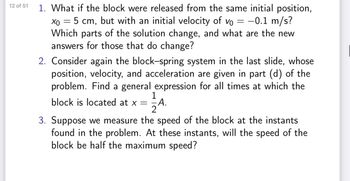6 A 200-g block connected to a light spring for which the force constant is 5.00 N/m is free to oscillate on a frictionless, horizontal surface. The block is displaced 5.00 cm from equilibrium and released from rest. (a) Find the period of its motion. (b) Determine the maximum speed of the block (c) What is the maximum acceleration of the block? (d) Express the position, velocity, and acceleration as functions of time in SI units.
6 A 200-g block connected to a light spring for which the force constant is 5.00 N/m is free to oscillate on a frictionless, horizontal surface. The block is displaced 5.00 cm from equilibrium and released from rest. (a) Find the period of its motion. (b) Determine the maximum speed of the block (c) What is the maximum acceleration of the block? (d) Express the position, velocity, and acceleration as functions of time in SI units.
College Physics
11th Edition
ISBN:9781305952300
Author:Raymond A. Serway, Chris Vuille
Publisher:Raymond A. Serway, Chris Vuille
Chapter1: Units, Trigonometry. And Vectors
Section: Chapter Questions
Problem 1CQ: Estimate the order of magnitude of the length, in meters, of each of the following; (a) a mouse, (b)...
Related questions
Question
100%

Transcribed Image Text:6
A 200-g block connected to a light spring for which the force constant is 5.00 N/m is free to oscillate on
a frictionless, horizontal surface. The block is displaced 5.00 cm from equilibrium and released from
rest.
(a) Find the period of its motion.
(b) Determine the maximum speed of the block
(c) What is the maximum acceleration of the block?
(d) Express the position, velocity, and acceleration as functions of time in SI units.
Expert Solution
This question has been solved!
Explore an expertly crafted, step-by-step solution for a thorough understanding of key concepts.
This is a popular solution!
Trending now
This is a popular solution!
Step by step
Solved in 4 steps with 4 images

Follow-up Questions
Read through expert solutions to related follow-up questions below.
Follow-up Question

Transcribed Image Text:12 of 51
=
-0.1 m/s?
Vo
1. What if the block were released from the same initial position,
хо
5 cm, but with an initial velocity of
Which parts of the solution change, and what are the new
answers for those that do change?
2. Consider again the block-spring system in the last slide, whose
position, velocity, and acceleration are given in part (d) of the
problem. Find a general expression for all times at which the
1
block is located at x =
A.
2
=
3. Suppose we measure the speed of the block at the instants
found in the problem. At these instants, will the speed of the
block be half the maximum speed?
Solution
Recommended textbooks for you

College Physics
Physics
ISBN:
9781305952300
Author:
Raymond A. Serway, Chris Vuille
Publisher:
Cengage Learning

University Physics (14th Edition)
Physics
ISBN:
9780133969290
Author:
Hugh D. Young, Roger A. Freedman
Publisher:
PEARSON

Introduction To Quantum Mechanics
Physics
ISBN:
9781107189638
Author:
Griffiths, David J., Schroeter, Darrell F.
Publisher:
Cambridge University Press

College Physics
Physics
ISBN:
9781305952300
Author:
Raymond A. Serway, Chris Vuille
Publisher:
Cengage Learning

University Physics (14th Edition)
Physics
ISBN:
9780133969290
Author:
Hugh D. Young, Roger A. Freedman
Publisher:
PEARSON

Introduction To Quantum Mechanics
Physics
ISBN:
9781107189638
Author:
Griffiths, David J., Schroeter, Darrell F.
Publisher:
Cambridge University Press

Physics for Scientists and Engineers
Physics
ISBN:
9781337553278
Author:
Raymond A. Serway, John W. Jewett
Publisher:
Cengage Learning

Lecture- Tutorials for Introductory Astronomy
Physics
ISBN:
9780321820464
Author:
Edward E. Prather, Tim P. Slater, Jeff P. Adams, Gina Brissenden
Publisher:
Addison-Wesley

College Physics: A Strategic Approach (4th Editio…
Physics
ISBN:
9780134609034
Author:
Randall D. Knight (Professor Emeritus), Brian Jones, Stuart Field
Publisher:
PEARSON